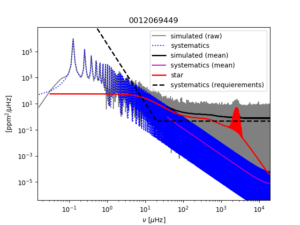The PLATO Solar-like Light-curve Simulator (PSLS) is Python tool that aims at simulating solar-like oscillators representative of PLATO targets. It includes planetary transits, stochastically-excited oscillations, granulation and activity background components, as well as instrumental systematic errors and random noises representative for PLATO.
For more details see PSLS in a nutshell.
If you use this simulator in your research, please cite Samadi et al (2019, A&A, 624, A117). Thanks !
New version 1.6 (06/01/23): I nclusion of a spot model based on Dorren (1987)’s model. Mode properties (frequencies, heights and linewidths) can now be specified with an input TEXT file. For more details see Change history
New version 1.5 (01/07/22): IMPORTANT bug correction: since version 1.0 a wrong value for the (square) visibility of the l=1 modes was used (0.2 instead of the correct value of 1.5), this bug led to a large underestimation of the amplitude of the l=1 modes.
Previous versions: see the change history HERE.
Caution: this simulator is not an official product of the Plato Mission Consortium (PMC), it is distributed under the terms of the GNU General Public License in the hope that it will be useful, but WITHOUT ANY WARRANTY.

Power spectrum of a simulated solar-like pulsating dwarf star as it would be observed during 2 years by PLATO.